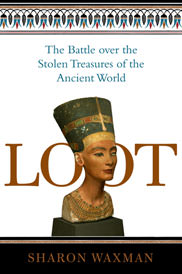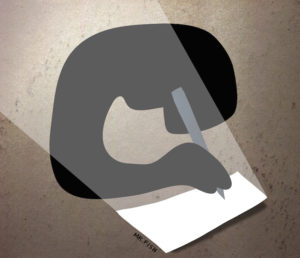Karl E. Meyer on Sharon Waxman’s ‘Loot’
A new book investigates the illicit trade in antiquities and raises uneasy questions over cultural patrimony, the fevers of nationalism and the imperial ambitions of museums.
I devoured “Loot: The Battle over the Stolen Treasures of the Ancient World” with particular zest, having published in 1973 an earlier account of the same cultural underworld, “The Plundered Past.” A seasoned reporter with an Oxford degree in Middle East studies, Sharon Waxman has updated and surpassed my explorations, in part because the outcry over the illicit traffic has reached fever pitch, provoking voluble, angry and indiscreet utterances from curators, collectors, dealers and a new breed of watchdogs, viz.:
“You end up thinking we’re all a bunch of looters, thieves, exploiters, that we’re some kind of criminals … but who would be interested in Greek sculpture if it were all in Greece? These pieces are great because they’re in the Louvre.” So protests Aggy Leroule, the Louvre’s press attaché, and so complain directors, trustees and publicists at the many great temples of art and archaeology. Yet there are also dissidents, an unlikely example being Thomas Hoving, once the acquisition-obsessed director of the Metropolitan Museum of Art and now a fallen Lucifer who recalls, almost with relish, his prevarications past.
Loot: The Battle over the Stolen Treasures of the Ancient World
By Sharon Waxman
Times Books, 432 pages
“Don’t be taken in,” he comments to Waxman. “ … It’s the old nineteenth-century ‘encyclopedic museum’ specious argumentation. It’s generally hogwash. I used to talk about it all the time when I was trying to finish a wing. It has nothing to do with reality, it’s just a phase of Westernization.” Actually, he goes on, in the 1950s and ’60s, European museums “didn’t much care about what they had.” Half of their collections were locked in storage, and “if you tried to see something on a scholarly basis, it took seven weeks.” So why shouldn’t American museums snap up antiquities, no matter how shady their provenance? “You did it because you wanted to boost your collection with beautiful things — and screw it. If you were a collecting curator back in the ’60s, of course you knew where it came from. This stuff is not found in Malibu.”
Hoving joined the Met in 1959 and reigned as director from 1966 until his forced resignation in 1977. Even as a novice curator, he recalls spending $850,000 a year on “stuff to be smuggled out of every country, mostly into Switzerland.” His superiors rationalized their complicity in this traffic in the belief that “we were saving something and putting it on view for an enormously wider audience. And we’d publish it. We thought we were adding to our collection, increasing our ego, getting promoted, and saving the world.” His signature coup was the purchase in 1972 of a peerless Greek vase, said to be from an old private collection, for a record $1 million. In truth, the calyx krater, painted and signed by Euphronios, was pillaged in Italy from an Etruscan tomb, sold to an expatriate American dealer of shady repute, spirited to Switzerland, secretly offered to the Met, flown to New York for its celebratory debut, and — following decades of charges and denials — finally returned to Italy in 2008 after each link in this chain had been conclusively established.
The first merit of Waxman’s book, the best on its subject, is her verbatim account of conversations with everybody who matters in the antiquities trade. This is especially true of her candid exchanges with the staffs and their overlords at the Louvre, the Met, the British Museum and the mega-endowed (circa $6 billion) J. Paul Getty Museum. As revealing are her encounters with the new flock of restitution hawks, led by Dr. Zahi Hawass, secretary-general of Egypt’s Supreme Council of Antiquities, who demands the return or loan of such stellar prizes as the British Museum’s Rosetta Stone, the Louvre’s Zodiac ceiling and Berlin’s bust of Nefertiti. When the Boston Museum of Fine Arts declined to lend Egypt its sculpture of Ankhaf (the reputed architect of the second-largest Giza pyramid), which it acquired legally in 1925, claming it was too fragile for export, Hawass raged over the telephone: “I’m going to make this museum’s life especially miserable. They’re assholes. Everything — they get for free. They should be punished. I will ban them from working in Egypt, completely, officially.”
Hawass is every major museum director’s nightmare, an avenging prosecutor, an agile politician and insatiable self-publicist. Continually visible on Egyptian television, he is also among the most formidable of the post-Nasser governing elite: at home with Americans, having earned his doctorate at the University of Pennsylvania, and wondrously able to energize the world’s most ancient and torpid bureaucracy. Almost single-handedly, Waxman writes, he succeeded in getting the Egyptian parliament to permit the King Tut treasures to travel abroad for the first time in 26 years, wresting terms for their multi-city tour that brought tens of millions back to Egypt. Yet with all that money (so my wife and I found in January), Cairo’s cavernous Egyptian Museum remains humid, ill-lit and badly labeled, much as it was when I first saw it in Nasser’s time. On the other hand: There are plans for a new archaeological showcase near the pyramids; Hawass has creditably established a fine new antiquities museum in Alexandria; and the recently opened Coptic Museum in Cairo, developed on his watch, deserves three stars. In short, as Waxman emphasizes, the looting controversy does not lend itself to glib moralizing: “[T]here are no easy answers here. No clear right and wrong as there was in the case of looted Nazi art. Context matters. Details matter. The broad brush-strokes of polemic end up distorting the picture rather than clarifying it. For one thing, it must be asked: is it fair to view events that date back 200 years through modern eyes? Is it appropriate to use words such as ‘stolen’ and ‘plundered’ for things taken when archeology was in its infancy, and when pioneering explorers did what they believed was best? … It is only in our modern age that the notion of ‘spoils of war’ has taken on a negative connotation. … And for those interested in balancing the scales of justice, where does it all end? The ancient Romans stole obelisks from Egypt, to which Renaissance sculptors added their own adornments. Should these be dismantled to return the obelisks to Egypt?”
Granted, we now have the 1970 UNESCO Convention on the Means of Prohibiting and Preventing the Illicit Export, Import and Transfer of Ownership of Cultural Property, currently binding 130 countries. Not only are signatories obliged to bar the importation of smuggled or stolen cultural artifacts, but they are encouraged to enact specific bans on imperiled antiquities from specific areas — as the United States has commendably done at the request of El Salvador, Guatemala, Honduras, Nicaragua, Peru, Mali and Cambodia. These bans have curtailed if not eliminated the traffic in monumental stelae and sculptured fragments chopped, even dynamited, from ancient edifices.
Loot: The Battle over the Stolen Treasures of the Ancient World
By Sharon Waxman
Times Books, 432 pages
However, while the convention does provide new legal weapons to countries seeking the return of looted or smuggled art, there is a less welcome downside. It also provides a cloak of virtue for nationalist politicians whose concern for the display and protection of ancient cultural treasures ceases once they have been restituted. A shaming case in point concerns the Lydian Hoard, a collection of 219 Hellenic gold and silver pieces smuggled from Turkey and acquired in the 1970s by the Metropolitan Museum. The Turks boldly sued the Met in 1987, and the case was strong enough to win back the treasures five years later in a negotiated settlement — an outcome that Turkey hailed as a national victory. But once returned, as Waxman relates, the long-sought hoard was negligently exhibited and its prize object, a golden hippocampus, was stolen from its case in a provincial museum in Usak and a crude counterfeit substituted in its place.
Of Turkey’s 93 government-operated museums, only 78 have electronic security systems, many of them defective. In 2007, Turkey devoted merely $66 million to operate all these museums and their staffs, plus 140 state-managed archaeological sites — a paltry two-tenths of 1 percent of the national budget. As in other antiquities-rich countries, inveighing against theft and smuggling is cost-free populism; seeking more funds for conservation and security finds scant reward in glory or votes. Let it be said in Dr. Zahi Hawass’ behalf that, whatever his thirst for publicity, he has pulled dynastic Egypt out of its musty tomb in the world’s popular imagination. And let it be said that while Sharon Waxman’s study offers no novel answers, she poses all the right questions.
Karl E. Meyer, a former staff member of The New York Times and The Washington Post, is the author of numerous books, including “The Plundered Past” and, most recently, with Shareen Blair Brysac, of “Kingmakers: The Invention of the Modern Middle East,” published by W.W. Norton.
Your support matters…Independent journalism is under threat and overshadowed by heavily funded mainstream media.
You can help level the playing field. Become a member.
Your tax-deductible contribution keeps us digging beneath the headlines to give you thought-provoking, investigative reporting and analysis that unearths what's really happening- without compromise.
Give today to support our courageous, independent journalists.










You need to be a supporter to comment.
There are currently no responses to this article.
Be the first to respond.